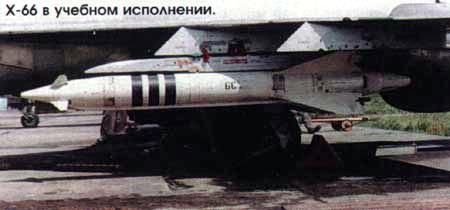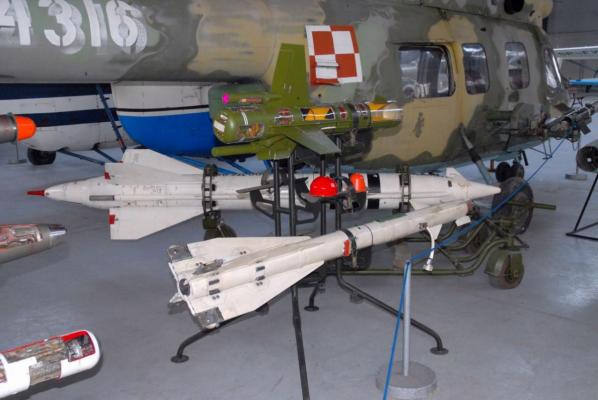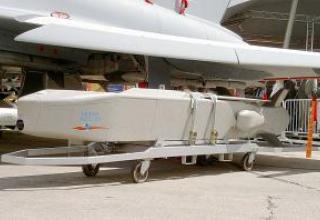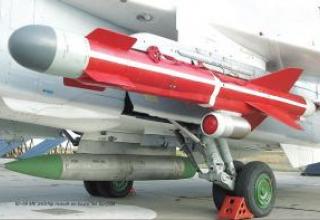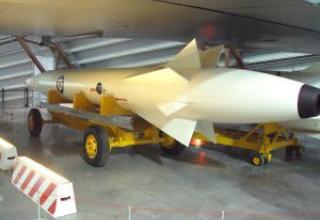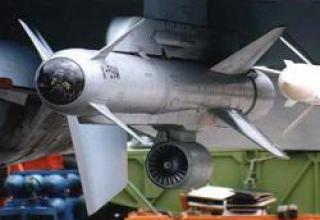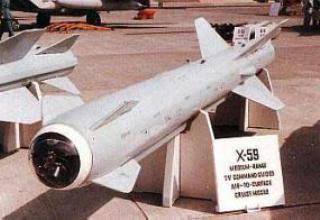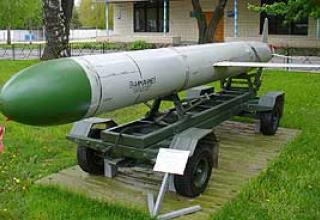With the increasing speed and altitude of frontline aircraft, the accuracy of traditional weapons has decreased dramatically. At the same time there was an improvement of air defense means and saturation of combat orders of the troops with them. All this led to the need to develop a new type of weapons - guided aircraft missiles.
The first tactical missile was to be X-23 with radio command guidance, but its development in OKB-134 was delayed due to problems with the guidance system. Then, in spring 1966, the Design Bureau of Plant ¹455 (later Zvezda Design Bureau) made a proposal to create a missile for frontline aviation on the basis of the already proven method of guidance by radar beam. The X-66 ("product 66") was designed under the guidance of Yu. N. Korolev and G.I. Khokhlov. Officially the work was started by the order of the Minister of Aviation Industry P.V.Dementiev from 12.03.1966.
Exceptional success, as well as short development and testing time of the X-66 missile was determined by its broad continuity in relation to the previously developed equipment - the newly created main elements of the missile were only the compartments and the combat unit. Were used some units from previously developed missiles: on-board radio command equipment and suspension unit from RS-2US, the engine from the R-8. Already in 1966, two telemetry and eight combat missiles were created. In 1967, the MiG-21PF ¹9400415 was re-equipped for flight tests started after three launches using a ground-based launcher. At stage A completed in the middle of the year from the aircraft was carried out seven autonomous launches from the dive and into the horizon. Since September 1967, as part of joint flight tests, 25 ground target launches were made. During the testing, poor roll stabilization and unreliability of the fuse were eliminated. The tests were carried out by pilots G.F. Fastovets, G.A. Gorovoy, M.M. Komarov and others.
In 1968, several dozens of X-66s were manufactured, and the subsequent production of "item 66" at the Kaliningrad plant increased by an order of magnitude. Later on, the missiles developed by the Zvezda Design Bureau were mass-produced at the Strela KMZ. This contributed to prompt elimination of inconsistencies between the design and technological documentation, active "feedback" between the production and the design team. Such interaction contributed to further improvement of the missile after its official adoption for service.
The excellent results of the firing made it possible to recommend the missile for service. This was done by the Government Decree of May 14, 1968 and in accordance with the order of the Head of the Ministry of Defense of June 20. The maximum range of the missile, according to these official documents, reached 8 kilometers with a limit deviation of 2.5 to 5 meters. The probability of hitting the target in a volley fire of two missiles was estimated at 0.36-0.7. MiG-21 was equipped with four X-66 missiles. They were launched at an interval of 0.4-0.6 seconds.
Experienced pilots, using X-66 missiles, confidently hit the targets. For example, during the demonstration of new equipment of the Government Commission VG Plyushkin first missile hit the target - the cockpit radar.
X-66 was used on the aircraft MiG-21PFM, MiG-21PFS, later on its base was developed rocket X-23.
Composition:
The X-66 missile is designed according to the aerodynamic scheme "duck" with an X-shaped arrangement of wing and rudder consoles (see projections) and includes the following functional systems:
- glider. Made of aluminum (25.5%) and magnesium (24.7%) alloys, except for the engine housing and combat unit made of steel (43%), is covered with anticorrosion coating and is technologically divided into six compartments, four wing consoles, each of which has an aileron, four rudders and gargles;
- engine PRD-204 (product Z96-Ps64) - single-chamber single-mode solid propellant rocket engine with an added powder charge. PRD-204, was developed on the basis of PRD-25 missile K-8M class "air-to-air". The main difference between the X-66 engine and the prototype was the use of a two-nozzle block instead of a central nozzle. The use of this scheme was due to the placement of a radio equipment unit in the tail of missiles. The engine was equipped with a cylindrical charge of NMF-2 nitroglycerine powder weighing 62 kg. The length of the charge was 870 mm, external diameter 244 mm, diameter of the central channel 44 mm. The charge was not armoured. Burning took place on the inner and outer cylindrical surfaces and from the ends. The engine PRD-204 had a total impulse of 10850 kgf, the maximum thrust of 3500 kg, operating time 4.0 ... 6.7 s, mass of 118 kg.
- The F-66 shrapnel-and-phugass-accumulated combat unit, consisting of a steel hull, which houses the equipment (explosive substance TG40) and has a socket for the fuse. It provides penetration of homogeneous armor up to 250 mm thick and defeat by type "C" of the radar cabin within a radius of 10 m;
- The fuse device EVU-N-29, consisting of the fuse EVU-N-29, in a cast body which is located in the long range unit and elements of the electrical circuit, and the reaction contact. Provides for detonation of a combat unit when a missile meets an obstacle no earlier than 4 ... 8 s after launch;
- control and stabilization equipment. It consists of two sensors of linear accelerations DA-11, two steering blocks for control by pitch and course DA-2SA and DA-ZSA, each of which included a control magnet, a two-stage damping gyroscope, a nozzle with an air pressure receiver and a steering air machine, and one block of roll DA-1, containing an integrating gyroscope with an arrow, a nozzle and a steering air machine with an air pressure receiver;
- guidance equipment 5I-1-B, consisting of a pin antenna, high-frequency part of the receiver, receiver and control unit and providing reception of radio signals from the onboard carrier radar and signals of linear accelerations sensors DA-11 and their conversion into control currents distributed on the control channels;
- the air system consisting of the pneumatic block, pipelines for air supply to the roll block for razzareretirovanija gyroscope and maintenance of work of the steering machine, and also razzaretivanija of gauges of accelerations, a collector and pipelines for air supply in working cylinders of steering blocks of promotion of damping gyroscopes, razzaretivanija rudders;
- an electrical system consisting of a 949F battery, electrical equipment and power supply.
The layout of the missile provides for assembly, docking, as well as technological replacement of its units and compartments, which is achieved by placing the equipment in the form of separate blocks:
- The 1st compartment is a reaction contact of an electric fusion device, made in the form of two cones isolated from each other;
- The 2nd compartment is made of two parts, in which the steering units DA-2S and DA-ZS (or DA-2S and DA-ZS), safety mechanism with a receipt, onboard power supply source are installed. Rudders are fixed on the case of the compartment;
- The third compartment is a combat unit with a fuse installed at the rear end;
- bay 4 is a powder rocket engine. On the body of the compartment are located engine start contacts and suspension units for the carrier;
- bay 5 - location of the roll unit DA-1 A, two sensors of linear accelerations, pneumatic block, electrical equipment elements. On the case of a compartment there are knots of fastening of consoles of a wing, and on the top there are onboard and control electric sockets;
- The 6th compartment is the location of the guidance equipment.

The main targets of the X-66 missile were missile launchers, radar cabins, armored vehicles, railway trains and lightweight ships. After detecting the target, the pilot dived to it, aiming at the collimator sight PKI with a fixed mark, while the beam of the radar RP-21M was "fixed" and coincided with the aiming mark. The missiles can be launched from the dive at an angle of 10...30°, either by single or multiple launch.
After pressing the action button the clock mechanism of program regulation of amplification by the range and power of the incoming radio signal is activated, the engine is launched, the rocket goes off the track and flies autonomously, stabilizing around the longitudinal axis. Approximately 1.5 seconds after the launch of the X-66 enters the beam of the on-board radar of the carrier and guidance equipment begins to produce signals to hold it on an equal line of radio reception. The X-66 radio control equipment was two independent identical channels, which produced signals to control its movement in two perpendicular planes. The missile's onboard equipment controlled and stabilized in the control planes and stabilized on the heel. At the end of the active flight section the fuse is fully detonated and the missile is fully ready for detonation, which occurs when it meets an obstacle. Until then, the pilot must hold the mark of the sight on the target.
The only carrier of the X-66 missile was the MiG-21PFM aircraft, which could take two missiles placed on the right and left wing suspension points on the launchers of the APU-68U. The accuracy of the guidance was influenced by both the guidance method itself, depending on the range, and the composition of the carrier equipment, which did not have an SAU, allowing to dampen the aircraft's own vibrations and, therefore, the radio reception. The central mark of the sight at the maximum range covered the small target, interfering with the aiming.
The X-66 was the first serial domestic aviation missile designed to engage ground targets. It differed by low hit accuracy and the possibility of application only with good visibility of the target. Launch and guidance of the X-66 missile made it difficult to pilot the aircraft and restrained maneuver (maneuvering could lead to the withdrawal of the missile from the narrow radio reception and loss of control).
Series production of the rocket began at the Kaliningrad Engineering Plant in 1968, and by 1972 was released 1175 missiles of this type. After 1972, in the process of serial production, the X-66 were installed:
- engine PRD-228 (item 393-11) from rocket X-23, which had higher power and performance characteristics in comparison with PRD-204. It allowed 50 takeoffs instead of 5, could be used in tropical conditions and at kinetic heating of ±150 ° C;
- an ampoule air block (from an X-23 missile) instead of an air block, which resulted in improvements to the missile's air system;
- the IBE-66 power supply unit (includes two 9B16 thermochemical batteries) instead of the 949F battery, which caused changes in the electrical equipment and electrical circuit of the missile and allowed to increase the aiming range up to 10 km and controlled flight time up to 19s.
As noted above, pointing the X-66 was provided by long (up to 20 seconds) holding the sight and, therefore, the fuselage of the aircraft in the direction of the target. In low-altitude flight necessary to defeat the target aircraft is exposed to significant disturbances, which significantly reduced the accuracy of the X-66. In this regard, in 1972 - 1976 years for the MiG-21PFM aircraft was developed a modification of the radar RP-21MI with a system of damping the radar beam. According to the results of tests, which confirmed an increase in missile accuracy by 1.8-2 times, it was recommended in a series, but the X-66 at this time was removed from production, and later from armament.
Another development, which was to expand the scope of X-66 missiles, was also late with its implementation. This missile was used exclusively from MiG-21s, but Su-7s and later on, MiG-23s and Su-17s were regarded as the basis for front line aviation at that time. In this connection, in 1973, the Beam Container System was developed, which ensured the use of X-66 missiles from any carrier. The following year, the Ray was tested by MiG-23M No 608. However, by this time was completed development of radio command missile X-23, practiced X-25 guided by laser beam, and X-66 missile was considered as unpromising.
Characteristics:
| 1969 issue | issued in 1974. | |
| Dimensions, mm: length fuselage diameter plumage scale |
3631 275 811 |
|
| Starter weight, kg | 278 | |
| Weight of combat unit, kg | 103 | |
| Flight Speed, m/s: maximum medium (range, km) minimum endpoint |
700 430-600 (6) 300 |
700 420-570 (8) 300 |
| Launch range, km: maximum minimum |
6 3 |
10 3 |
| Time of controlled flight, s | up to 15 | up to 25 |
| Available overload, g | 11 | |
| Accuracy (Yekno), m | 8.2 | |
| Speed range of the carrier aircraft, km/h. | 560-1100 | |
| Height range, m | 50-5000 | |
Testing:
Having unique flight and tactical characteristics, MiG-25P for a long time was operated only as part of the Soviet air defense fighter aircraft. In the early 1980s, its delivery abroad began, and soon its baptism of fire took place. Even before the beginning of the large-scale Lebanese conflict, in spring 1981, the Syrians announced the destruction of the F-15.
According to the Iraqi Air Force Command, from December 1982 to October 1986, during the Iran-Iraq war, the Iraqi MiG-25 shot down an Iranian F-5E fighter, an EU-130E counter-electronic aircraft, and three Phantoms, including one in a reconnaissance version.
During Operation Desert Storm, January 17, 1991, Iraqi MiG-25 managed to shoot down an American F/A-18, and in 2002 - an unmanned reconnaissance drone Predeitor.
Sources:
- Карпенко А.В., Ганин С.И. Отечественные авиационные тактические ракеты // Невский бастион. - 2000. - №1. - С. 18.
- Марковский В.Ю., Перов К. Советские авиационные ракеты "воздух-земля". - М.: "Экспринт", 2005. - С. 5-6.
- Марковский В.Ю., Перов К. Советские авиационные ракеты "воздух-земля" // М-Хобби. - 2002. - № 3. - С. 32-36.
- Широкорад А.Б. История авиационного вооружения. - Мн.: "Харвест", 1999. - С. 338
- Ангельский Р. Звезда сияла в Королеве, "Техника и вооружение вчера, сегодня, завтра", 2005.- №5
